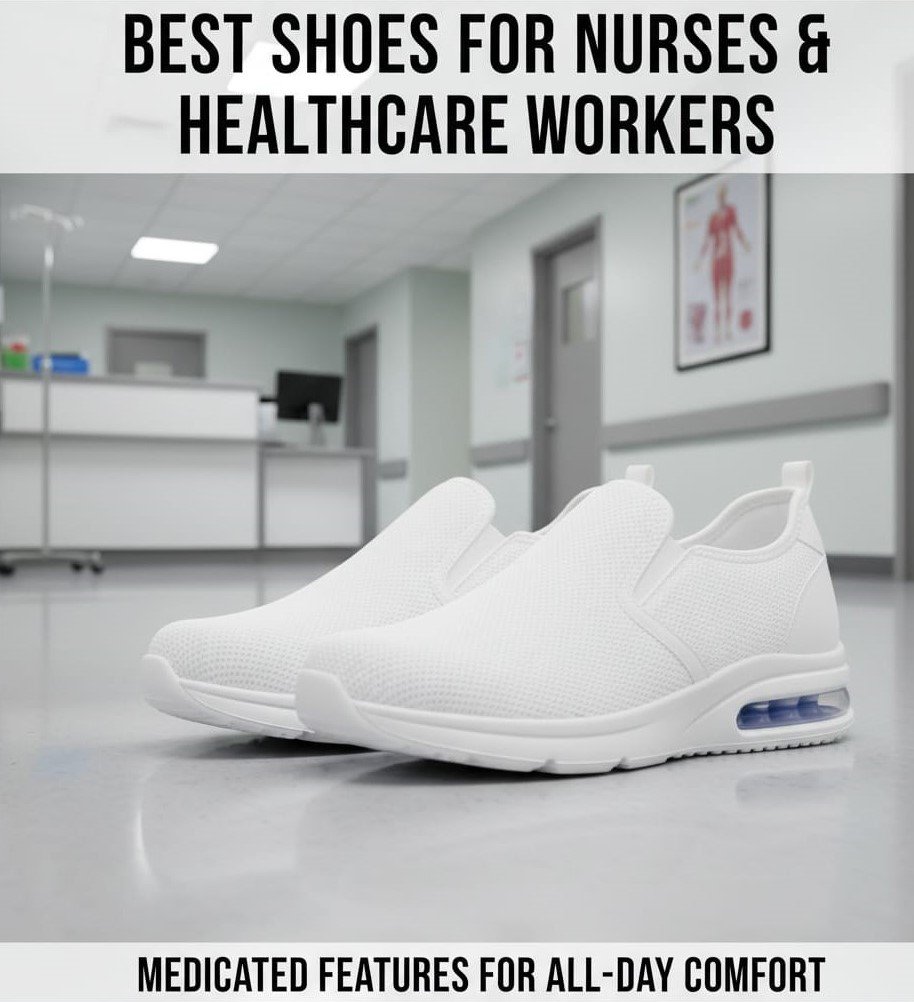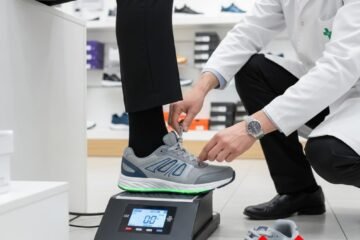It covers what “medicated” features mean in this context, why they matter for healthcare professionals, what to look for, and ends by recommending strong shoe models (with citations). You can add your own branding, links, and product images as desired.
🩺 Introduction: The Long Shift and the Right Shoes
If you’re working in healthcare — whether as a nurse, technician, ward assistant, or any role that has you on your feet for long hours — your choice of footwear matters. Hospital floors, constant motion, sudden turns, standing and walking for hours: it’s a heavy load on your feet, ankles, knees, and back.
“Medicated shoes” in this context are those that incorporate specialized features built for support, durability, shock absorption, stability, and conditions that come from long periods on your feet — all beyond what a typical casual shoe delivers.
This article will help you understand:
- Why standard shoes often fail healthcare settings
- What medicated / therapeutic features to look for
- How to match your foot‑profile and role to the right option
- Top shoe models & brands that hit the mark
🔍 Why Regular Shoes Often Fall Short in Healthcare Environments
Standard shoes (casual sneakers, dress shoes, basic slip‑ons) may look fine, but they often lack the features that matter for long shifts and healthcare settings. Key issues many healthcare workers face:
- Persistent heel or arch pain by mid‑shift
- Slipping / losing grip on smooth or wet floors
- Feet swelling (especially after 8‑12 hours) and shoe feeling tight
- Fatigue from minimal cushioning or lack of shock absorption
- Footwear that doesn’t accommodate orthotics or foot conditions
For example, one nurse on Reddit explains:
“Nurses walk thousands of steps per shift. The right shoes can prevent foot, leg, and back pain while supporting long‑term career health.”
Likewise, many reviews emphasise features like arch support, slip resistance and durable materials as “must‑haves”.
🧰 Key Medicated Features to Look For in Nurse & Healthcare Shoes
Below are the core attributes you should prioritize. Each feature targets common stressors in healthcare settings.
1. Arch & Heel Support
Strong support in these areas helps align your foot, reduce over‑pronation or other gait issues, and relieve pressure on the plantar fascia, knees and lower back.
Brands such as Brooks highlight wide width options, arch support and cushioning as top reasons for recommendation in nurse shoes.
2. Cushioning & Shock Absorption
Healthcare workers frequently walk over hard surfaces (tile, linoleum, cement) which means impact forces are higher. The right midsole foam, gel inserts or cushioning tech make a big difference.
For instance, the “Most Comfortable” shoes list mentions shock absorption and cushioning as key for nursing shoes.
3. Slip‑Resistant Outsole & Traction
In hospital or clinical environments there are fluid spills, quick transitions, slippery surfaces. Slip resistance isn’t just a nice‐to‐have—it’s a safety feature.
One review signals: “Slip‑resistant outsole is essential for preventing slips and falls, particularly in busy healthcare environments.”
4. Breathability & Materials
Long shifts cause foot fatigue, heat, moisture build‑up. Shoes that breathe and use durable, comfortable uppers will help.
Many nurse‑approved shoes emphasize mesh uppers or breathable designs.
5. Removable Insoles & Orthotic Compatibility
Many healthcare workers may need extras: orthotics, inserts for arch issues or plantar fasciitis, etc. Shoes that allow insole removal and replacement support that flexibility.
For example, the APMA‑approved shoes noted often mention removable insoles.
6. Fit, Width Options & Room for Swelling
Especially after long hours, feet swell. Shoes that have wide/extra‑wide options, roomy toe boxes, and stable fit are beneficial.
One article lists multiple width options for nurses as a key attribute.
7. Durability & Easy Maintenance
Healthcare shoes face washes, spills, frequent use. Materials that are easy to clean, resistant to stains/fluids, and built to last make them better value. For instance, one recommendation for nurse shoes includes “easy to clean” leather uppers.
📊 Comparison Chart: Medicated Features vs Standard Nurse Shoes
Here’s a handy table to scan how medicated features compare to standard footwear options.
| Feature | Medicated/Healthcare‑Grade Shoe | Standard Shoe |
|---|---|---|
| Arch & Heel Support | High, designed for alignment, long‑standing wear | Minimal to moderate support |
| Cushioning & Shock Absorption | Advanced foam, gel inserts, designs for hard surfaces | Basic foam, variable durability |
| Slip‑Resistant Outsole | Certified or designed for hospital floors / fluid spills | Often general‑purpose tread, less grip |
| Breathable & Durable Uppers | Mesh/leather combinations, easy to clean, fluid resistant | Often fashion‑first materials, less focus on durability |
| Removable Insole/Orthotic Compatible | Yes, often designed to accept custom inserts | Frequently fixed insole, limited options |
| Width/Room for Swelling | Wide/extra‑wide, roomy toe box, stable fit | Often standard widths, may feel tight |
| Value / Lifetime | Built for long hours, dozens of shifts, better ROI | May wear out faster under heavy use |
👟 Top Shoe Models for Nurses & Healthcare Workers
Here are some strong choices frequently recommended by nurses, reviewed in healthcare‑environment contexts:
- Hoka One One Bondi SR – known for its thick cushioning, support and APMA acceptance.
- Brooks Ghost 15 – nurse‑approved for long hours, good arch support, multiple widths.
- Clove Classic – designed specifically for healthcare, fluid resistant, easy to clean.
- Nike Structure or Vomero 18 – supportive midsole builds, recommended for healthcare work.
- Dansko Professional Clog – long‑time favorite among nurses for support and ease of cleaning.
💡 Tip: If you link to these shoes in your blog, consider including affiliate or comparison links (if applicable) and note that fit and features vary by model/version.
✅ How to Choose & Maintain Your Nurse Work Shoes
Here’s a step‑by‑step guide to pick the right pair and keep them working well shift after shift:
- Understand your specific foot needs – e.g., arch height, previous foot issues (plantar fasciitis, flat feet), ankle/knee pain.
- Choose shoes with medicated features – use the list above to guide your selection.
- Fit test at the end of a shift – feet are most swollen then; try on shoes after work or after walking around.
- Walk a few minutes in them – test for heel slippage, toe box comfort, arch alignment.
- Check width & size options – many brands now offer wide/extra‑wide; good fit matters.
- Rotate between two pairs – allows cushioning materials to rebound and extends life.
- Replace timely – even the best shoes wear out; signs include flattened midsoles, uneven wear, new foot pain.
- Clean & maintain – wipe down materials, allow dry time, avoid puddles when possible, and consider adding insoles or orthotics if needed.
One nurse shared:
“I wear compression socks and Hokas… 12 and 16‑hr shifts are a breeze.”
This highlights how shoe plus sock plus support combination matters too.
🌟 Final Thoughts
Being on your feet all day in a healthcare role demands more than just “comfortable shoes”. You need footwear that understands the nature of your work: long hours, walking and standing, burst movements, slippery floors, heavy gear. Medicated/healthcare‑grade shoes deliver that extra layer of support, durability, and wellness.
Choose shoes that ride the intersection of function (support, stability, durability) and comfort (fit, breathability, materials). Your feet (and body) will thank you — shift after shift.


